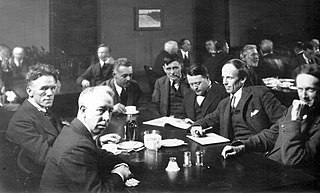
Meteor Crater, or Barringer Crater, is an impact crater about 37 mi (60 km) east of Flagstaff and 18 mi (29 km) west of Winslow in the desert of northern Arizona, United States. The site had several earlier names, and fragments of the meteorite are officially called the Canyon Diablo Meteorite, after the adjacent Canyon Diablo.

Crater Lake is a volcanic crater lake in south-central Oregon in the Western United States. It is the main feature of Crater Lake National Park and is famous for its deep blue color and water clarity. The lake partly fills a 2,148-foot-deep (655 m) caldera that was formed around 7,700 years ago by the collapse of the volcano Mount Mazama. No rivers flow into or out of the lake; the evaporation is compensated for by rain and snowfall at a rate such that the total amount of water is replaced every 150 years. With a depth of 1,949 feet (594 m), the lake is the deepest in the United States. In the world, it ranks tenth for maximum depth, as well as third for mean (average) depth.

The Chicxulub crater is an impact crater buried underneath the Yucatán Peninsula in Mexico. Its center is offshore, but the crater is named after the onshore community of Chicxulub Pueblo. It was formed slightly over 66 million years ago when an asteroid, about ten kilometers in diameter, struck Earth. The crater is estimated to be 200 kilometers in diameter and 1 kilometer in depth. It is believed to be the second largest impact structure on Earth, and the only one whose peak ring is intact and directly accessible for scientific research.

The Group of Seven, once known as the Algonquin School, was a group of Canadian landscape painters from 1920 to 1933, with "a like vision". It originally consisted of Franklin Carmichael (1890–1945), Lawren Harris (1885–1970), A. Y. Jackson (1882–1974), Frank Johnston (1888–1949), Arthur Lismer (1885–1969), J. E. H. MacDonald (1873–1932), and Frederick Varley (1881–1969). A. J. Casson (1898–1992) was invited to join in 1926, Edwin Holgate (1892–1977) became a member in 1930, and Lionel LeMoine FitzGerald (1890–1956) joined in 1932.

Arthur Lismer, LL.D. was an English-Canadian painter, member of the Group of Seven and educator. He is known primarily as a landscape painter and for his paintings of ships in dazzle camouflage.

The far side of the Moon is the lunar hemisphere that always faces away from Earth, opposite to the near side, because of synchronous rotation in the Moon's orbit. Compared to the near side, the far side's terrain is rugged, with a multitude of impact craters and relatively few flat and dark lunar maria ("seas"), giving it an appearance closer to other barren places in the Solar System such as Mercury and Callisto. It has one of the largest craters in the Solar System, the South Pole–Aitken basin. The hemisphere has sometimes been called the "Dark side of the Moon", where "dark" means "unknown" instead of "lacking sunlight" – each location on the Moon experiences two weeks of sunlight while the opposite location experiences night.

Lunar craters are impact craters on Earth's Moon. The Moon's surface has many craters, all of which were formed by impacts. The International Astronomical Union currently recognizes 9,137 craters, of which 1,675 have been dated.

Victoria is an impact crater on Mars located at 2.05°S, 5.50°W in the Meridiani Planum extraterrestrial plain, lying situated within the Margaritifer Sinus quadrangle (MC-19) region of the planet Mars. This crater was first visited by the Mars Exploration Rover Opportunity. It is roughly 800 metres (2,600 ft) wide, nearly eight times the size of the crater Endurance, visited by Opportunity from sols 951 to 1630.

Humberside Collegiate Institute, formerly known as Toronto Junction High School and Toronto Junction Collegiate Institute is a public high school located in Toronto, Ontario, Canada. It serves the Bloor West Village, Baby Point, High Park North and Junction neighbourhoods. Prior to 1998, it was within the Toronto Board of Education (TBE).

Verdi is an impact crater on the planet Mercury. It was named after Italian Romantic composer Giuseppe Verdi (1813–1901) in 1979, as recognized by the International Astronomical Union. The crater's extensive ejecta blanket and secondary crater field are superposed on plains materials and older craters.
The Shop Stewards Movement was a movement which brought together shop stewards from across the United Kingdom during the First World War. It originated with the Clyde Workers Committee, the first shop stewards committee in Britain, which organised against the imprisonment of three of their members in 1915. Most of them were members of the Amalgamated Society of Engineers (ASE). In November 1916 the Sheffield Workers Committee was formed when members of the ASE there went on strike against the conscription of a local engineer. The government brought the strike to an end by exempting craft union members such as ASE engineers from military service. However, when this policy was reversed in May 1917, this was met by a strike involving 200,000 workers in 48 towns. The Shop Stewards Movement arose from organising this strike.

Yvonne Williams (1901–1997) was a stained glass artist, known for her design and creation of stained glass windows in Canada, including the windows in St. John's Shaughnessy in Vancouver, Chalmers United Church in Guelph, Ontario and St. Michael & All Angels Church in Toronto.
Edward Lismer was a British trade unionist and political activist.

Henri is a crater on Mercury. It has a diameter of 163.8 kilometres. Its name was adopted by the International Astronomical Union (IAU) on April 24, 2012. Henri is named for American painter Robert Henri.













